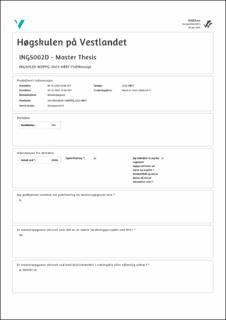Assessing the Efficacy of Open-State Cavity Barriers with improper installation through intermediate-scale testing
Master thesis
Permanent lenke
https://hdl.handle.net/11250/3122918Utgivelsesdato
2023Metadata
Vis full innførselSamlinger
Sammendrag
The tragic Grenfell Tower fire in 2017 was worsened by combustible materials within the building structure. Following this incident, Fire risk appraisal of external wall construction and cladding of existing blocks of flats – Code of practice (PAS 9980) was introduced to conduct risk-based fire assessments in existing buildings, evaluating aspects such as fire performance, façade configuration, and fire safety strategy. However, PAS 9980 lacks clear criteria for assessing deficiencies in wall systems, both with and without fire barriers. There is limited research on open-state cavity barrier configurations, hindering comprehensive understanding. A collaborative project involving Western Norway University of Applied Science and SOCOTEC UK with the support of SIDERISE UK aims to evaluate the impact of faulty cavity barrier installations identified in different scenarios.
By conducting site visits and utilizing data from intrusive survey reports on external walls, major defective installation methods in existing buildings were identified. Six different scenarios, posing potential high impacts due to improper installation of open-state cavity barriers, were tested on an intermediate scale. These scenarios include gaps between two blocks of cavity barriers, blockages in front of cavity barriers, increased cavity size, and performance of cavity barriers in the corners of external wall.
Results from the study revealed that gaps larger than 30 mm allowed fire to propagate to the upper compartment. Blockages up to 50 mm in front of cavity barriers prevented temperature rise and flame propagation to the upper compartment with a time delay in the reduction in temperature. An increased cavity gap, surpassing the prescribed limit for the cavity barrier in accordance with manufacturer guidelines by up to 50%, resulted in a proportional extension of the closure time of the cavity by 20-30%. This extension significantly contributed to the prevention of flame propagation and temperature elevation in the upper compartment, demonstrating the efficacy of the modified configuration. In the case of corners, improper closure of the cavity was primarily attributed to the lack of intumescent material. However, the temperature in the upper compartment adhered to the guidelines required by TGD19.
The findings of this investigation underscore the significance of workmanship in the construction of wall envelope compositions to attain the necessary level of fire protection. The conclusion of the study emphasizes that disruptions in the consistency of cavity barriers during on-site installation represent a crucial factor that demands careful consideration. The paper suggests an approach for evaluating and understanding the implications of such incidents within the specified wall envelope configuration.
Beskrivelse
Master thesis in Fire Safety Engineering

